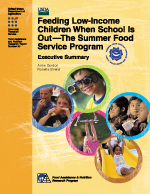Feeding Low-Income Children When School Is Out-The Summer Food Service Program: Executive Summary
- by Anne Gordon, Ronette Briefel and Jane E. Allshouse
- 4/25/2003
Overview
The U.S. Department of Agriculture, through the Summer Food Service Program (SFSP), funds meals for children in low-income areas when school is not in session. USDA's Economic Research Service recently sponsored the first comprehensive study of the SFSP in more than a decade. The nationally representative study surveyed State administrators, sponsor staff, and site staff on program operations and on factors that affect participation. The study also examined the nutritional quality of meals served and the extent of plate waste. In fiscal year 2001, more than 4,000 local sponsors provided about 130 million meals at more than 35,000 feeding sites. The number of children served in July (2.1 million) was about 14 percent of the number who received free or reduced-price school meals during the previous school year.
In an effort to help target potential SFSP expansion efforts, ERS has developed the Summer Food Service Program Map Machine. The interactive web machine combines data on 2001 SFSP sponsors and sites, Census 2000 data on small geographic areas, and school census data. Users can create maps that allow them to infer at a glance whether SFSP sites are located in areas of the highest need, and whether some qualified areas have been overlooked. The Map Machine also allows for in-depth analysis of program coverage. See the Food Access Research Atlas.
See also: Feeding Low-Income Children When School Is Out-The Summer Food Service Program: Final Report.
Download
-
Entire report
Download PDF

